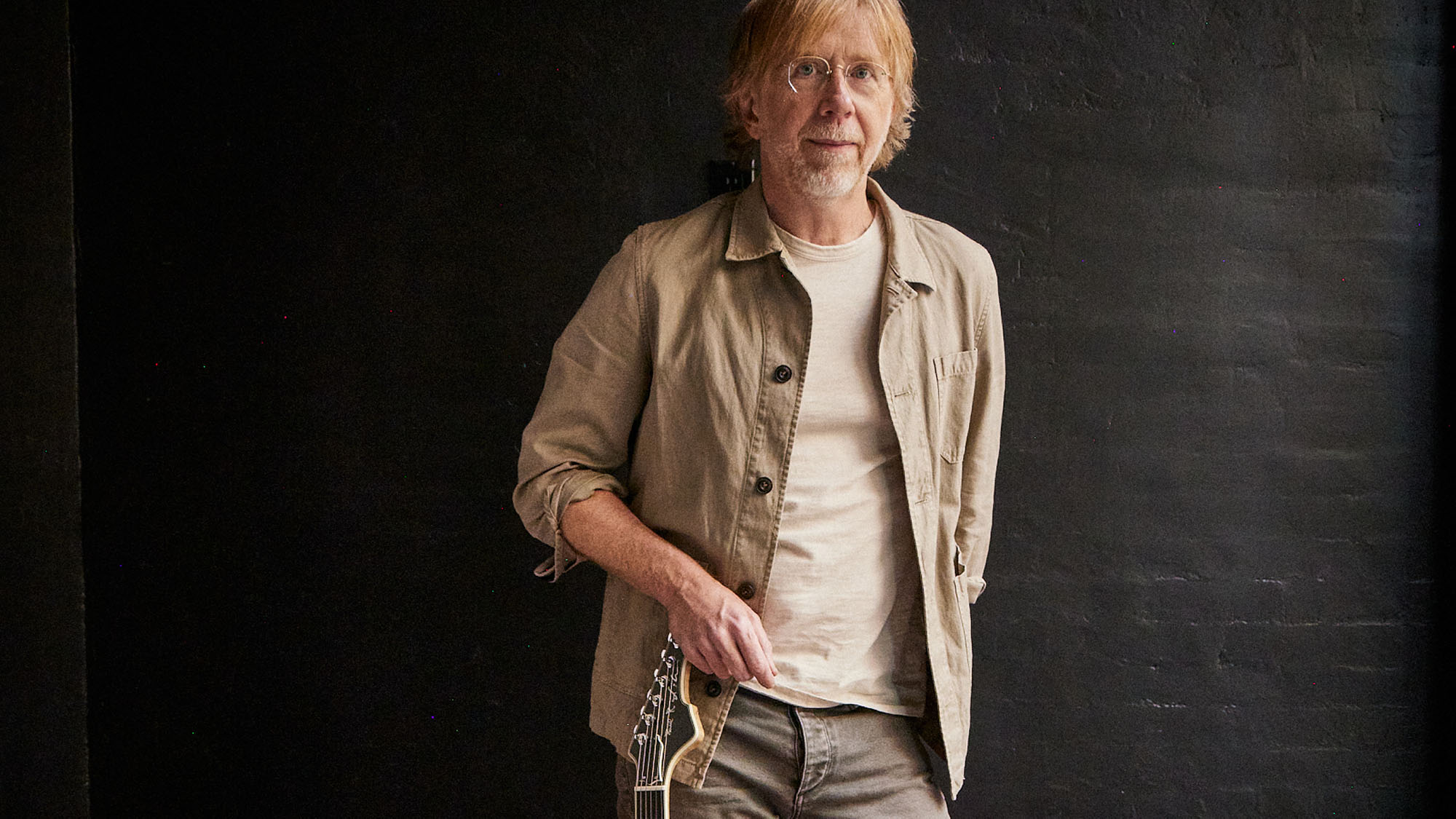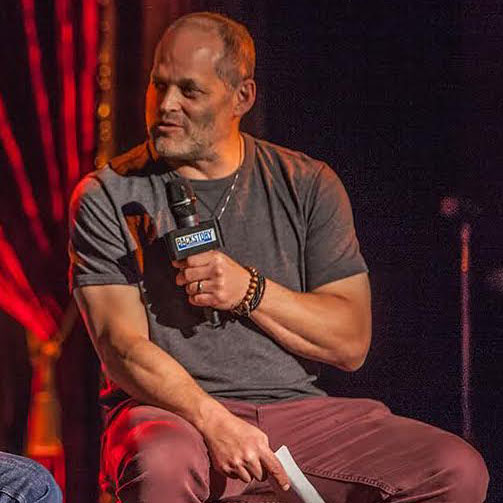“I’m almost getting scared about my love affair with this guitar – I’m worried what I would do if something happened to it”: Trey Anastasio on the creation of his “perfect” custom Languedoc guitars – and the genius who made them (who only sees mistakes)

Phish guitarist Trey Anastasio is rarely seen without one of his custom Paul Languedoc guitars – the koa builds that have accompanied him on ever Guitar World cover to date.
The instrument stands out for both its design and sound, created as a hybrid of several guitars – and sonic templates – merged into one to Anastasio’s varying demands. It has remained a staple of his live rig and played a huge part in the creation of some of Phish’s most critically acclaimed work.
In this interview, he digs into the origins of the design, and why it just kept cropping up on GW covers…
Although you’re holding your main Paul Languedoc guitar (Koa 1) during this interview, you’re actually holding Koa 2 on your two previous GW covers. How did the whole Languedoc connection come about?
“I met my friend Paul Languedoc in about 1983. He was a Burlington [Vermont] luthier who worked at Time Guitars and became my roommate and our first crew member – and for a long time, the only crew member.
“He was our sound man, but so much more. He had already made me a couple of guitars at Time – a solidbody and a miniature guitar that I traveled with. It was a six-string guitar that was so small I could put it in my backpack. I wrote a lot of early songs on that, including You Enjoy Myself.”

“Paul, who is a genius, said, ‘I’m gonna build you a guitar. What do you want?’ At the time I was listening to a lot of jazz. I was really into Django Reinhardt, Pat Metheny and Wes Montgomery, which you can hear in the writing. I was trying to access the harmonic language of jazz, but I also loved Jimi Hendrix and Led Zeppelin. So I asked him if I could have a guitar that does it all – which everybody always wants!
Get The Pick Newsletter
All the latest guitar news, interviews, lessons, reviews, deals and more, direct to your inbox!
“His suggestion was a hollowbody with a Strat-scale length, long enough to twang. He came up with this shape and made me the first one. That prototype was the blonde ‘Mar Mar’ guitar, so named because I put [an image of] our dog – who used to travel with us – on [the headstock]. We have to give Paul credit where credit is due; he designed this unique-sounding guitar, and I started writing music that fit to the sound.”

What’s an example of that?
“The best example I can think of is The Squirming Coil. The music in the middle section is some of my favorite composed music I’ve ever done. That guitar really had a midrange-y quality, because as a young guitar player two of my favorite guitarists were Robert Fripp in his Bowie era and the killer Queen, Brian May, who is still the greatest midrange guitarist ever.
“This guitar allowed me to access that ‘wooooo’ tone, because it was a hollow body with long scaling. I started using it and writing a lot, so Paul said he wanted to make me one out of koa, and he gave me [Koa 1] in 1996.”
It’s basically the same guitar, but with…
“…Koa, more or less. But while Paul was developing it, he was making changes. We’d practice in his garage while he built guitars next to us, and he started building his own tools and normalizing the guitar.
“This prototype is not normalized yet, so it has a few weird qualities – like, the neck is really thin, almost like a Strat. He chose to start making the necks more like Les Pauls, and he also moved the rear pickup forward so it would be a little bit kinder to that central position. This one is a lot farther back, next to the bridge.
“But this is the guitar I carried around with me everywhere and wrote so much central music on. The years 1996-99 were a really crazy time for Phish, with the festivals and everything, and this was glued to my body through that whole period. It was backstage at Big Cypress [a three-day New Year’s event at the Big Cypress Seminole Indian Reservation in Florida, 1999 into 2000] in the midst of all these big parties, and I basically slept with it – wake up and start practicing.”

“I played it so much that I wore out the neck. So in 2002 he built me another one, a guitar we call Koa 2. I would play it a while and then go back to Koa 1 because [Koa 1] is like a phantom limb. Paul was frustrated, saying, ‘The new one is better. I made a lot of mistakes on 1 that I fixed.’
“The craftsmanship on the newer ones is insane. He started using hardwood binding, for instance. They’re amazing guitars – works of art. Then he built me the ‘Ocelot’ guitar [Koa 3], which is astounding. I love it, but I’d play it for a while then pick up the ’96 guitar again. [Laughs] We had a little head-butt about it, because Paul would say, ‘It’s not as good!’ And I’m like, ‘Yeah, I know what you mean, but…’”
Is it the feel or the sound that makes you feel that way?
“Both! If I remember this correctly, I asked him to put a piece of lead in here. We were living together, and I’d just get an idea and say, ‘Hey man, can you do this?’ It had a bone nut and he put a brass one on to make it a little more twangy, less wooden-sounding. Then we were doing coil-taps, all that. Just trying things.
“During Covid, he made me Koa 4 [aka “the 4.0 Guitar”] and, my God, it’s gorgeous. But while I love them all, my love affair with this guitar has gotten out of hand, and it overwhelms the others. I’ve never loved an inanimate object the way I love this guitar. I didn’t even know it was possible.”

I saw a picture of you holding a Stratocaster at Billy Strings’ wedding last year, and it looks so strange.
“Yes! Billy was playing my guitar and he loved it. Vance Powell, the great engineer and producer we’ve worked with, told me that recording engineers talk and say that there’s only one person who makes this guitar sound right, though people buy them. It’s a very unique tone.
“I’m almost getting scared about my love affair with this guitar, because I’m worried what I would do if something happened to it. This thing is fucking magic. It has all the things I wanted when I talked to Paul back in the day about my dream guitar. He looks at this guitar and sees mistakes, but I see perfection.”

That’s why it’s sitting in your apartment and the other ones are in a studio, rehearsal space or equipment truck.
“And it’s not the easiest one to play! The newer ones play better. I don’t even know what he did, but the new ones are perfect. You can bend strings more easily, they’re lighter and don’t hurt my neck as much. But I’ve played so many hours and written so many songs on it that I feel like…”
Like it’s part of you!
“Yes. It’s starting to scare me how attached I am to this guitar. If there were a fire and I was running out of the house, it’s the only object I would try to save. It would be [his wife] Sue, the cats, the dog and the guitar. Everything else can be replaced.”
- Evolve is out now via JEMP.
Alan Paul is the author of three books, Texas Flood: The Inside Story of Stevie Ray Vaughan, One Way Way Out: The Inside Story of the Allman Brothers Band – which were both New York Times bestsellers – and Big in China: My Unlikely Adventures Raising a Family, Playing the Blues and Becoming a Star in Beijing, a memoir about raising a family in Beijing and forming a Chinese blues band that toured the nation. He’s been associated with Guitar World for 30 years, serving as Managing Editor from 1991-96. He plays in two bands: Big in China and Friends of the Brothers, with Guitar World’s Andy Aledort.
“Even the thought that Clapton might have seen a few seconds of my video feels surreal. But I’m truly honored”: Eric Clapton names Japanese neo-soul guitarist as one to watch
“You better be ready to prove it’s something you can do”: Giacomo Turra got exposed – but real guitar virtuosos are being wrongly accused of fakery, too













